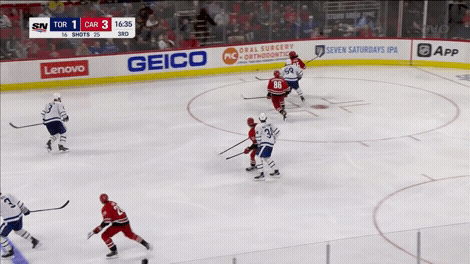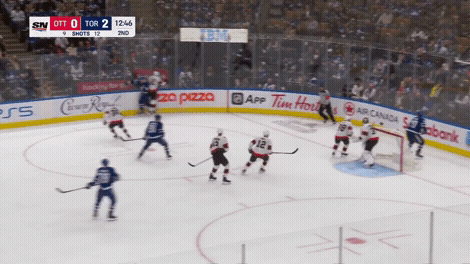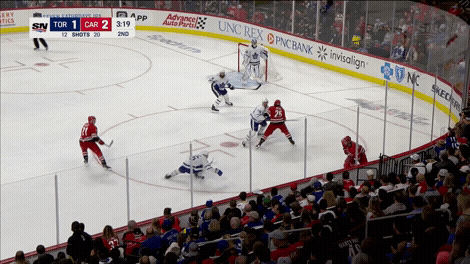The start of the Maple Leafs' 2021-22 campaign has been defined by disappointing losses. While it’s early in the season, the pressure is quickly mounting in Toronto. Each step back only casts more doubt on their long-term hopes and whether they have what it takes to actually make a lengthy playoff run, let alone win it all.
Losing what could become pivotal points is concerning; the Maple Leafs have only claimed five out of a possible 14 points so far. But does their 2-4-1 record truly reflect their level of play to open the season?
At their core, the Maple Leafs just aren’t scoring nearly as much as they should be.
Before Tuesday night’s matchups, the Maple Leafs led the league in puck possession time spent in the offensive zone at 5-on-5. Even when pro-rating that to account for their seven games played (versus the four matches others had played at this point), they only slip down to second, just behind the Florida Panthers.
Within the offensive zone, Toronto is generating one of the highest rates of shot attempts and creating a lot from the slot — a rate of 7.52 shots per 60, which puts them fourth in the league. About 37 per cent of their shots are coming from that slot area, as the heat map below helps show. It’s also where most of their few 5-on-5 goals have been scored.

So, what’s going wrong?
As much as Toronto is shooting, it’s not always translating to shots on goal. Few teams have missed as many attempts at the net, or seen as many of their shots get blocked.
Still, based on the quality of their shots, without the added factor of their shooting ability, the Maple Leafs are expected to score at one of the highest rates in the league to open the season. But they’ve managed a lowly 1.79 goals for per 60 at 5-on-5 thus far. In fact, the differential between their expected goal rate and actual goal rate is the worst in the league at 1.53.

An average shooting team would be expected to have about nine more goals than Toronto currently does. This team has quite a few elite and top-tier offensive talents -- they just aren’t finishing.
The Maple Leafs’ scoring woes start at, but aren’t limited to, the top of their lineup. Just three goals at 5-on-5 have been scored between their core four offensive stars in Auston Matthews, Mitch Marner, William Nylander, and John Tavares. But that group is expected to be closer to seven tallies.

Nylander, at least, has been standing out elsewhere -- from his transitional play to his shooting to start the year. Matthews, of course, missed the first few games while recovering from wrist surgery. Since his return, though, a lower percentage of his shots have come from the slot compared to last season. And Marner’s attempted a higher rate of passes to the slot, but has had less success connecting. On the whole, this team obviously needs more from their best.
Ideally, when a team’s top players are struggling, the rest of the team can pick up the slack. But they too have been falling shy of expectations (although, combined, not to the same extent as the Leafs’ best). When the losses add up so early in the season as a result of that lack of scoring, especially in Toronto, it puts their start under a microscope.

Making matters worse is that their scoring deficit has trickled on to the power play as well.
Here, the Leafs aren’t shooting at the highest rate in the league. They are, however, shooting from the slot and inner slot more often than most. But they’re still not converting, scoring about four goals fewer than expected.
What’s hurting their case even more is their play at the other end of the ice. Jake Muzzin, TJ Brodie, and Justin Holl are among the defenders in Toronto who have gotten off to a particularly rough start.

Last year, as a whole, the Maple Leafs limited their opponents to a rate of just 2.10 expected goals against at 5-on-5 as they protected the net-front area to support their goaltenders. This season, on the other hand, they’ve conceded a higher rate of quality shots expected (2.88 expected goals against per 60) and left their netminders exposed to more slot shots against than most of the league.
With those defensive deficits to start the season, it amps up the need for more offence to overcome it, and right now, they simply can't seem to outscore those weaknesses.
What comes next?
Toronto’s last two losses have been their worst. Against Pittsburgh, the Maple Leafs may have out-attempted their opponent, but they passed to the slot less, and created fewer chances from that dangerous area of the ice.
Then when facing off against one of their strongest opponents yet in the Hurricanes, Toronto shot the puck less and generated fewer scoring chances than their opponent, hence the lower expected goal total once again. Of all their losses, this may have been their most understandable given the strength of Carolina.
But it stands out that Toronto couldn’t get past the Sharks, who aren’t projected to go far this season, or the Sidney Crosby-less Penguins.
It’s possible that the early losses are just weighing on them and led to collapses in their last two games. As much as a team could be doing what appears to be the right thing offensively, eventually enough losses are going to shake their confidence -- maybe even more so with the pressure of last season still influencing them.
Still, the Leafs should find their footing sooner than later. And these next few games provide their best opportunity yet. First, against a Blackhawks team that’s an absolute disaster on and off the ice, and missing quite a few players in COVID-19 protocol. Then Saturday, against a Red Wings team that shouldn’t be underestimated especially with rookie Lucas Raymond’s line on the ice, but isn’t particularly deep.
Sometimes, a team just needs the bounces to go their way so they can fully breakout offensively, and that seems true for the Maple Leafs — although, it’s clearly not all they need to get to the level that’s expected of them. While losing these points could bite them later, it also helps to work out these woes now and not during the most crucial points in the season, or post-season.
Data via Sportlogiq, collected prior to Tuesday night’s matchups.
